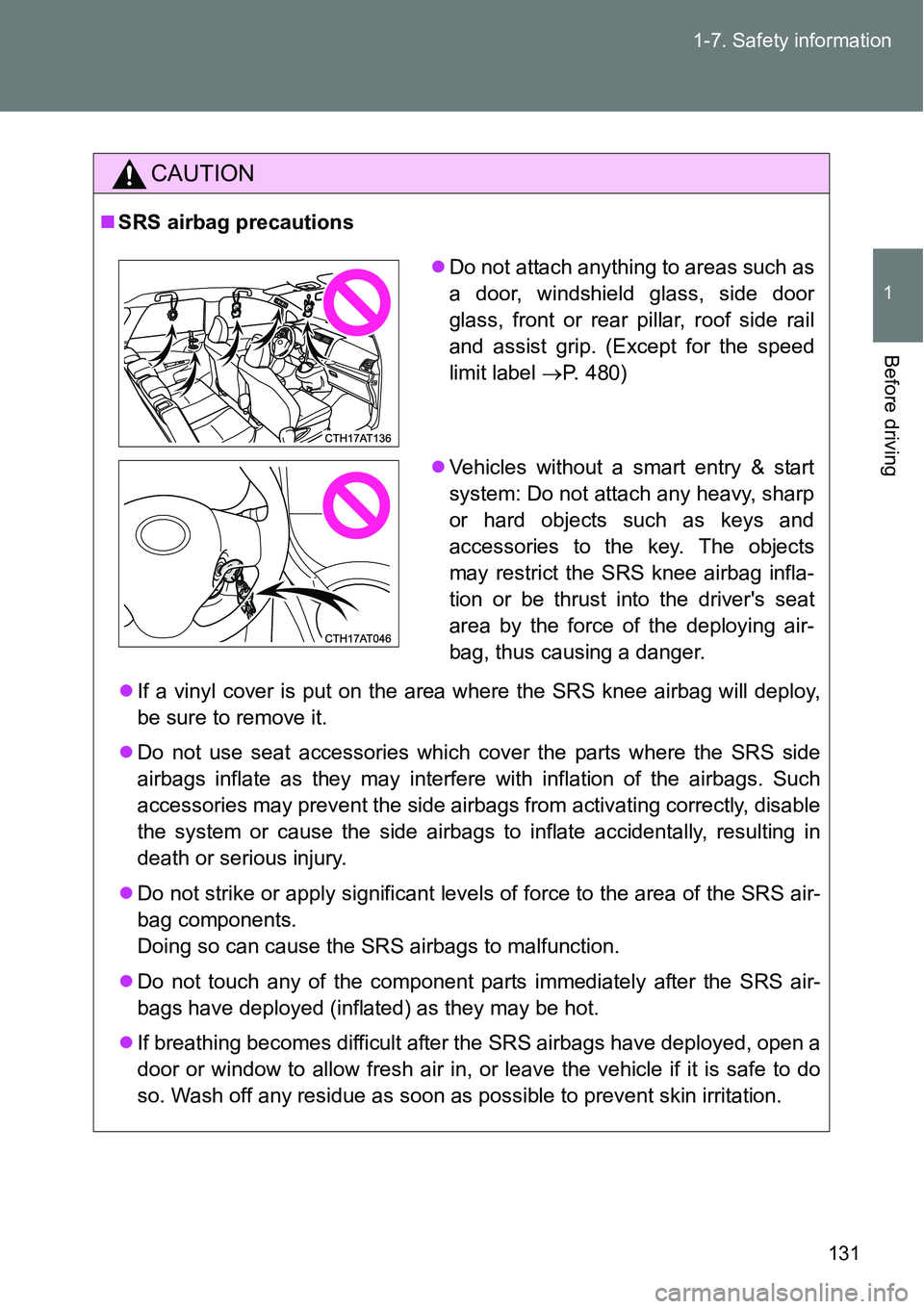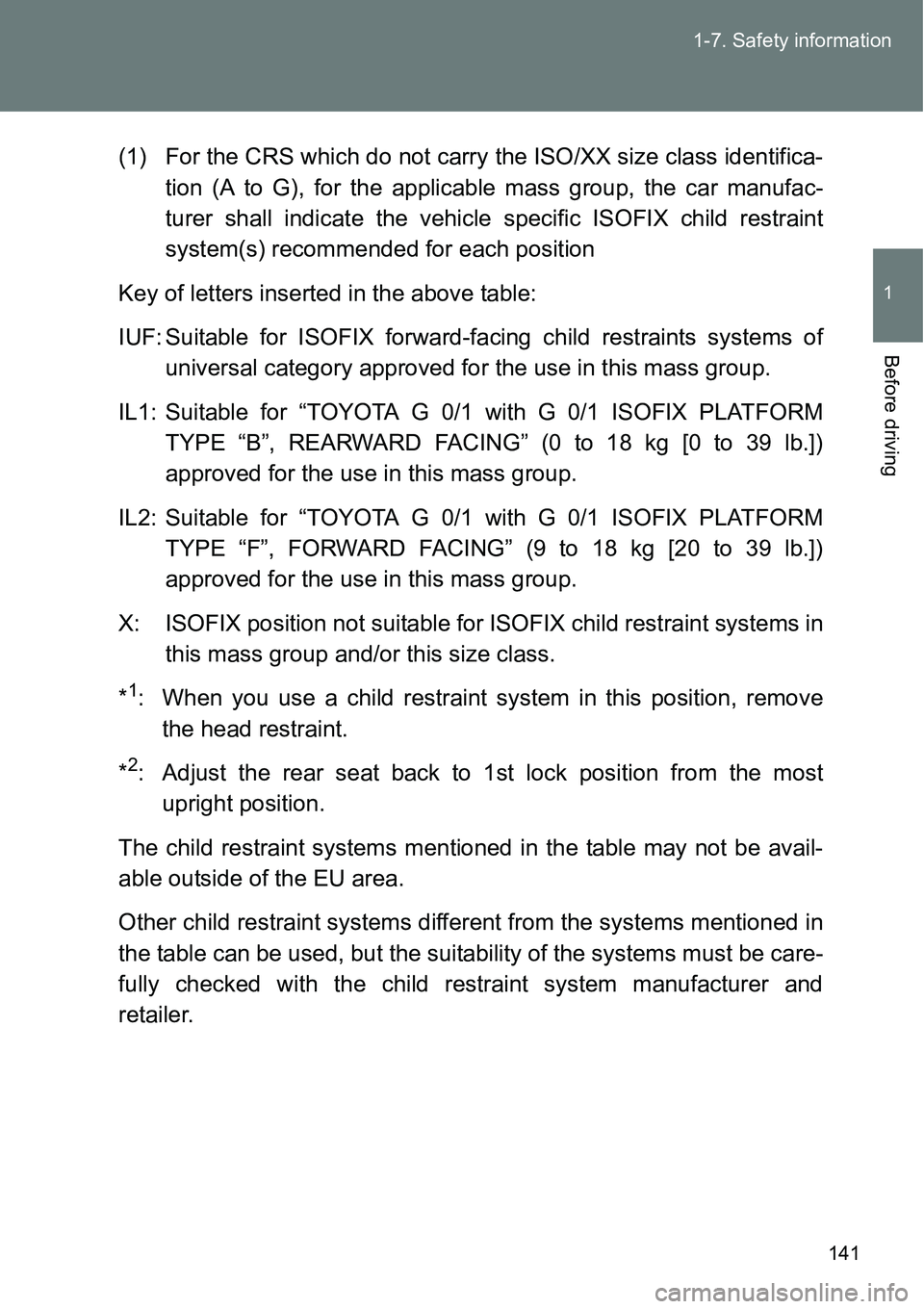Page 105 of 564
105
1
Before driving
1-6. Theft deterrent system
Engine immobilizer system
The vehicle's keys have built-in transponder chips that prevent the
engine from starting if a key has not been previously registered in
the vehicle's on-board computer.
Never leave the keys inside the vehicle when you leave the vehicle.
This system is designed to help prevent vehicle theft but does not
guarantee absolute security against all vehicle thefts.
Vehicles without a smart
entry & start system
The indicator light flashes after
the key has been removed
from the engine switch to indi-
cate that the system is operat-
ing.
The indicator light stops flash-
ing after the registered key
has been inserted into the
engine switch to indicate that
the system has been can-
celed.
Page 106 of 564
106 1-6. Theft deterrent system
System maintenance
The vehicle has a maintenance-free type engine immobilizer system.
Conditions that may cause the system to malfunction
If the grip portion of the key is in contact with a metallic object
If the key is in close proximity to or touching a key to the security system
(key with a built-in transponder chip) of another vehicle
Vehicles with a smart entry
& start system
The indicator light flashes after
the “ENGINE START STOP”
switch has been turned off to
indicate that the system is
operating.
The indicator light stops flash-
ing after the “ENGINE START
STOP” switch has been turned
to ACCESSORY or IGNITION
ON mode to indicate that the
system has been canceled.
Page 118 of 564
118 1-6. Theft deterrent system
System maintenance
The vehicle has a maintenance-free type alarm system.
Items to check before locking the vehicle
To prevent unexpected triggering of the alarm and vehicle theft, make sure
of the following.
Nobody is in the vehicle.
The windows are closed before the alarm is set.
No valuables or other personal items are left in the vehicle.
Triggering of the alarm
The alarm may be triggered in the following situations.
(Stopping the alarm deactivates the alarm system.)
Vehicles without a smart entry & start
system: The doors are unlocked using
the key.
Vehicles with a smart entry & start sys-
tem: The doors are unlocked using the
mechanical key.
A person inside the vehicle opens a
door or the hood.
The battery is recharged or replaced
when the vehicle is locked.
Page 119 of 564
119 1-6. Theft deterrent system
1
Before driving
Alarm-operated door lock
When the alarm is operating, the doors are locked automatically to pre-
vent intruders.
Do not leave the key inside the vehicle when the alarm is operating, and
make sure the key is not inside the vehicle when recharging or replacing
the battery.
Customization that can be configured at any authorized Toyota dealer
or repairer, or another duly qualified and equipped professional
Settings of the alarm using the key can be changed.
(Customizable features: P. 540)
NOTICE
To ensure the system operates correctly
Do not modify or remove the system. If modified or removed, the proper
operation of the system cannot be guaranteed.
Page 131 of 564

131 1-7. Safety information
1
Before driving
CAUTION
SRS airbag precautions
If a vinyl cover is put on the area where the SRS knee airbag will deploy,
be sure to remove it.
Do not use seat accessories which cover the parts where the SRS side
airbags inflate as they may interfere with inflation of the airbags. Such
accessories may prevent the side airbags from activating correctly, disable
the system or cause the side airbags to inflate accidentally, resulting in
death or serious injury.
Do not strike or apply significant levels of force to the area of the SRS air-
bag components.
Doing so can cause the SRS airbags to malfunction.
Do not touch any of the component parts immediately after the SRS air-
bags have deployed (inflated) as they may be hot.
If breathing becomes difficult after the SRS airbags have deployed, open a
door or window to allow fresh air in, or leave the vehicle if it is safe to do
so. Wash off any residue as soon as possible to prevent skin irritation.
Do not attach anything to areas such as
a door, windshield glass, side door
glass, front or rear pillar, roof side rail
and assist grip. (Except for the speed
limit label P. 480)
Vehicles without a smart entry & start
system: Do not attach any heavy, sharp
or hard objects such as keys and
accessories to the key. The objects
may restrict the SRS knee airbag infla-
tion or be thrust into the driver's seat
area by the force of the deploying air-
bag, thus causing a danger.
Page 134 of 564
134 1-7. Safety information
Deactivating the front seat passenger airbag
Vehicles without a smart entry
& start system
Insert the key into the cylinder
and turn to the “OFF” position.
The “OFF” indicator light turns on
(only when the engine switch is in
the “ON” position).
Vehicles with a smart entry &
start system
Insert the mechanical key into
the cylinder and turn to the
“OFF” position.
The “OFF” indicator light turns on
(only when the “ENGINE START
STOP” switch is in IGNITION ON
mode).
“PASSENGER AIR BAG” indicator information
If any of the following problems occur, it is possible that there is a malfunc-
tion in the system. Have the vehicle inspected by any authorized Toyota
dealer or repairer, or another duly qualified and equipped professional.
Neither “ON” nor “OFF” comes on.
The indicator light does not change when the airbag manual on-off switch
is switched to “ON” or “OFF”.
Page 139 of 564

139 1-7. Safety information
1
Before driving
Key of letters inserted in the above table:
U: Suitable for “universal” category child restraint system approved
for the use in this mass group.
UF: Suitable for forward-facing “universal” category child restraint
system approved for the use in this mass group.
L1: Suitable for “TOYOTA G 0+, BABYSAFE PLUS with SEAT BELT
FIXATION, BASE PLATFORM” (0 to 13 kg[0 to 28 lb.]) approved
for the use in this mass group.
L2: Suitable for “TOYOTA DUO+” (without ISOFIX, 9 to 18 kg [20 to
39 lb.]) approved for the use in this mass group.
L3: Suitable for “TOYOTA KID” (15 to 36 kg [34 to 79 lb.]) approved
for the use in this mass group.
L4: Suitable for “TOYOTA G 0/1” (without ISOFIX, 9 to 18 kg [20 to
39 lb.]) approved for the use in this mass group.
L5: Suitable for “TOYOTA KIDFIX” (15 to 36 kg [34 to 79 lb.])
approved for the use in this mass group.
X: Not suitable seat position for children in this mass group.
*
1: When you use a child restraint system in this position, remove
the head restraint.
*
2: Adjust the rear seat back to 1st lock position from the most
upright position.
*
3: Adjust the front seat back to upright position.
The child restraint systems mentioned in the table may not be avail-
able outside of the EU area.
Other child restraint systems different from the systems mentioned in
the table can be used, but the suitability of the systems must be care-
fully checked with the child restraint system manufacturer and
retailer.
Page 141 of 564

141 1-7. Safety information
1
Before driving
(1) For the CRS which do not carry the ISO/XX size class identifica-
tion (A to G), for the applicable mass group, the car manufac-
turer shall indicate the vehicle specific ISOFIX child restraint
system(s) recommended for each position
Key of letters inserted in the above table:
IUF: Suitable for ISOFIX forward-facing child restraints systems of
universal category approved for the use in this mass group.
IL1: Suitable for “TOYOTA G 0/1 with G 0/1 ISOFIX PLATFORM
TYPE “B”, REARWARD FACING” (0 to 18 kg [0 to 39 lb.])
approved for the use in this mass group.
IL2: Suitable for “TOYOTA G 0/1 with G 0/1 ISOFIX PLATFORM
TYPE “F”, FORWARD FACING” (9 to 18 kg [20 to 39 lb.])
approved for the use in this mass group.
X: ISOFIX position not suitable for ISOFIX child restraint systems in
this mass group and/or this size class.
*
1: When you use a child restraint system in this position, remove
the head restraint.
*
2: Adjust the rear seat back to 1st lock position from the most
upright position.
The child restraint systems mentioned in the table may not be avail-
able outside of the EU area.
Other child restraint systems different from the systems mentioned in
the table can be used, but the suitability of the systems must be care-
fully checked with the child restraint system manufacturer and
retailer.